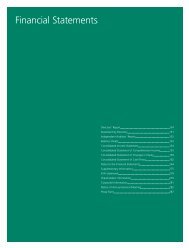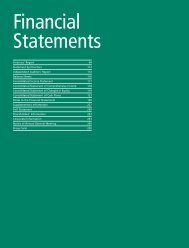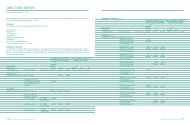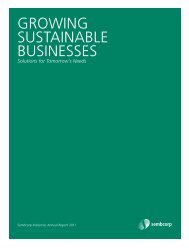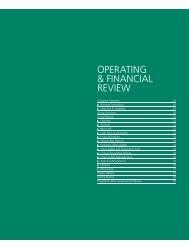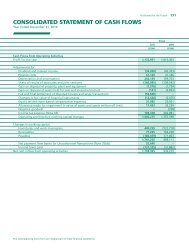FINANCIAL STATEMENTS (Full Version) - Sembcorp
FINANCIAL STATEMENTS (Full Version) - Sembcorp
FINANCIAL STATEMENTS (Full Version) - Sembcorp
Create successful ePaper yourself
Turn your PDF publications into a flip-book with our unique Google optimized e-Paper software.
Notes to the<br />
Financial Statements<br />
Year Ended December 31, 2008<br />
2. SUMMARY OF SIGNIFICANT ACCOUNTING POLICIES (cont’d)<br />
v. Revenue Recognition (cont’d)<br />
iv. Service Concession Arrangement (cont’d)<br />
The Group recognises the consideration received or receivable as a financial asset to the extent that it has an<br />
unconditional right to receive cash or another financial asset for the construction services. Financial assets are<br />
accounted for in accordance with the accounting policy set out in Note 2(g).<br />
The Group recognises the consideration receivable as an intangible asset to the extent that it receives a right<br />
to charge users of the public service. Intangible assets are accounted for in accordance with the accounting<br />
policy set out in Note 2(f).<br />
v. Dividend and Interest Income<br />
Dividend income is recognised in the income statement when the right to receive payment is established.<br />
Interest income is recognised as it accrues, using the effective interest method.<br />
vi. Rental Income<br />
Rental income receivable under operating leases is recognised in the income statement on a straight-line basis<br />
over the term of the lease. Lease incentives granted are recognised as an integral part of total rental income,<br />
over the term of the lease.<br />
w. Leases<br />
i. Operating Lease<br />
When entities within the Group are lessees of an operating lease<br />
Where the Group has the use of assets under operating leases, payments made under the leases are recognised<br />
in the income statement on a straight-line basis over the term of the lease. Lease incentives received are<br />
recognised in the income statement as an integral part of the total lease payments made.<br />
ii.<br />
When entities within the Group are lessors of an operating lease<br />
Assets subject to operating leases are included in investment properties and are stated at cost less accumulated<br />
depreciation and impairment losses. Rental income (net of any incentives given to lessees) is recognised on a<br />
straight-line basis over the lease term.<br />
Finance Lease<br />
When entities within the Group are lessors of a finance lease<br />
Amounts due from lessees under finance leases are recorded as receivables at the amount of the Group’s net<br />
investment in the leases. Finance lease income is allocated to accounting periods so as to reflect a constant<br />
periodic rate of return on the Group’s net investment outstanding in respect of the leases.<br />
x. Finance Costs<br />
Interest expense and similar charges are expensed in the income statement in the period in which they are incurred,<br />
except to the extent that they are capitalised as being directly attributable to the acquisition, construction or<br />
production of an asset which necessarily takes a substantial period of time to prepare for its intended use or<br />
sale. The interest component of finance lease payments is recognised in the income statement using the effective<br />
interest rate method.<br />
2. SUMMARY OF SIGNIFICANT ACCOUNTING POLICIES (cont’d)<br />
y. Segment Reporting<br />
A segment is a distinguishable component of the Group that is engaged either in providing products or services<br />
(business segment), or in providing products or services within a particular economic environment (geographical<br />
segment), which is subject to risks and rewards that are different from those of other segments.<br />
z. Assets (or Disposal Groups) Held For Sale<br />
Non-current assets (or disposal groups) are classified as assets held for sale and measured at the lower of carrying<br />
amount and fair value less costs to sell if they are expected to be recovered principally through a sale transaction<br />
rather than through continuing use.<br />
Any impairment losses on initial classification and subsequent measurement are recognised in the income<br />
statement. Subsequent increases in fair value less costs to sell are recognised in the income statement (not<br />
exceeding the accumulated impairment loss that has been previously recognised).<br />
aa. Financial Guarantee Contracts<br />
Financial guarantee contracts are accounted for as insurance contracts and treated as contingent liabilities until<br />
such time as they become probable that the Company will be required to make a payment under the guarantee.<br />
A provision is recognised based on the Group’s estimate of the ultimate cost of settling all claims incurred but<br />
unpaid at the balance sheet date. The provision is assessed by reviewing individual claims and tested for adequacy<br />
by comparing the amount recognised and the amount that would be required to settle the guarantee contract.<br />
3. SHARE CAPITAL<br />
Group and Company<br />
No. of ordinary shares<br />
2008 2007<br />
Issued and fully paid:<br />
At the beginning of the year 1,783,782,546 1,770,177,555<br />
Exercise of share options 1,568,994 13,604,991<br />
At the end of the year 1,785,351,540 1,783,782,546<br />
a. The holders of ordinary shares are entitled to receive dividends as declared from time to time and are entitled to<br />
one vote per share at meetings of the Company. All shares rank equally with regard to the Company’s residual<br />
assets.<br />
b. As at December 31, 2008, there were 10,533,580 (2007: 15,510,729) unissued ordinary shares granted under the<br />
Company’s Share Option Plan.<br />
c. Movements of the share capital account during the year are set out in the Consolidated Statement of Changes in<br />
Equity.<br />
136 Delivering Essential Solutions <strong>Sembcorp</strong> Industries Annual Report 2008 137




